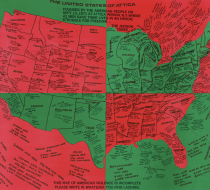United States of Attica Favorite
In September 1971, after years of mistreatment and months of simmering tensions, more than 1,200 of the 2,200 inmates at the Attica Correctional Facility in upstate New York took control of the prison in protest of its substandard conditions and openly racist corrections officers. (As in many American prisons to this day, the vast majority of Attica’s inmates at the time were Black or Latino, while its officers were overwhelmingly white.) The prisoners took around 40 hostages, including guards and civilians, and over several days attempted peaceful negotiations with officials to improve their living conditions. Under orders from Governor Nelson Rockefeller, state police retook the prison by force, killing 39 people, both prisoners and hostages. In the aftermath, authorities attempted to prosecute various prisoners for their role in the uprising, but even though much of the violence was perpetrated by the state, none of the officials responsible for the deaths ever saw any formal charges. Faith Ringgold’s poignant, incendiary response to this tragedy was “The United States of Attica,” a map of the U.S., rendered in the green, red and black of Marcus Garvey’s Pan-African flag. The map is filled in with the dates and details of other American atrocities — anti-Chinese riots in Oregon in the 1880s, the Trail of Tears in Oklahoma that killed some 4,000 Cherokee Indians, the lynching of Emmett Till in Mississippi, the 1968 assassination of Dr. Martin Luther King Jr. in Tennessee, riots in California, Michigan and Texas — so much violence that it can’t all fit on the page. (Statistics about deaths caused by America’s wars, from the Revolution to Vietnam, occupy the work’s margins.) “United States of Attica” is an alternate history of the U.S. that is rooted in loss and inequity, but also, above all, in the bravery of the oppressed as they fight for freedom. Ringgold produced the work as a popular poster that was widely distributed. At the bottom, the artist wrote, in a sadly predictive statement: “This map of American violence is incomplete.” — M.H. Miller
INTERVIEW
TLF: Nikil, what do think you protest art is?
Nikil Saval: My first instinct was to immediately think of posters. The first one I came up with was “Silence = Death.” I thought, well there is some kind of public standing when we think about protest art. And we can qualify what “public” means. But this is a very obvious instance in which an artwork was created in a collective over several months and was activated in various ways by a social movement to which it was directly tied. That led me to other kinds of works of art that had some connection to a social movement. I thought of Faith Ringgold’s “The United States of Attica.” It’s protest art not just because of what happened in Attica but also because it is a history of American violence. It’s also a map. It’s also a flag because it utilizes the colors of Marcus Garvey’s Pan-African flag. It’s also an invitation because at the very bottom of the image, it has instructions about how to insert your own statistics into it. So I think participation also, in some way, is a part of protest.
TLF: Ru, as the curator in the group, what were you thinking?
Ru Hockley: I was thinking about works that were intended to exist in multiple spheres and registers. It’s exciting that we’re all doing this together, because the first example I thought of was Dread’s flag “A Man Was Lynched by Police Yesterday.” The first time I ever saw that flag was at a protest in Union Square in 2016.







